South Africa and weapons of mass destruction
| South Africa | |
|---|---|
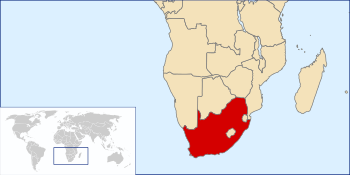 | |
| Nuclear program start date | 1967[1] |
| First nuclear weapon test |
Possible, 22 September 1979 (See Vela Incident) |
| First fusion weapon test | Unknown |
| Last nuclear test | Unknown |
| Largest yield test | Unknown |
| Total tests | Unknown |
| Peak stockpile | 6 |
| Current stockpile | None; the programme was voluntarily dismantled in 1989. |
| Maximum range | 1,300 kilometres (810 mi) (English Electric Canberra) |
| NPT signatory | Yes |
From the 1960s to the 1980s, South Africa pursued research into weapons of mass destruction, including nuclear,[2] biological, and chemical weapons. Six nuclear weapons were assembled.[3] Before the anticipated changeover to a majority-elected African National Congress government in the 1990s, the South African government dismantled all of its nuclear weapons, the first nation in the world which voluntarily gave up all nuclear arms it had developed itself.
The country has been a signatory of the Biological Weapons Convention since 1975, the Treaty on the Non-Proliferation of Nuclear Weapons since 1991, and the Chemical Weapons Convention since 1995.
Nuclear weapons
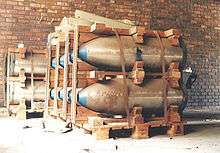
| Weapons of mass destruction |
|---|
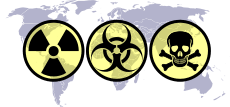 |
| By type |
| By country |
|
| Proliferation |
| Treaties |
|
The Republic of South Africa's ambitions to develop nuclear weapons began in 1948 after giving commission to South African Atomic Energy Corporation (SAAEC), the forerunner corporation to oversee nation's uranium mining and industrial trade.[1] In 1957, South Africa reached an understanding with the United States after signing a 50-year collaboration under the U.S.-sanctioned programme, the Atoms for Peace.[1] The treaty concluded the South African acquisition of a single nuclear research reactor and an accompanying supply of the highly enriched uranium (HEU) fuel, located in Pelindaba.[1]
In 1965, the American subsidiary, the Allis-Chalmers Corporation, delivered the 20MW research nuclear reactor, SAFARI-1, along with ~90% HEU fuel to South African nuclear authority.[1] In 1967, South Africa decided to pursue the plutonium capability and constructed its own reactor, SAFARI-2 reactor also at Pelindaba, that went critical using 606kg of 2% enriched uranium fuel, and 5.4 tonnes of heavy water, both supplied by the United States.[1]
The SAFARI-2 reactor was intended to be moderated by heavy water, fueled by natural uranium while the reactor's cooling system used molten sodium.[1] In 1969, the project was abandoned by the South African government because the reactor was draining resources from the uranium enrichment program that was initiated in 1967.[1] South Africa began focusing on the success of its uranium enrichment programme which was seen by its scientists as easier compared to plutonium.[1]
South Africa was able to mine uranium ore domestically, and used aerodynamic nozzle enrichment techniques to produce weapons-grade material. In 1969, a pair of senior South African scientists met with Sültan Mahmoud, a nuclear engineer from Pakistan based at the University of Birmingham, to conduct studies, research and independent experiments on uranium enrichment.[4] The South African and Pakistani scientists studied the use of aerodynamic-jet nozzle process to enrich the fuel at the University of Birmingham, later building their national programs in the 1970s.[4] It is not clear how much knowledge they gained and to what extent they cooperated.[4]
South Africa gained sufficient experience with the nuclear technology to capitalize on the promotion of the U.S. government's Peaceful Nuclear Explosions (PNE) program.[1] Finally in 1971, South African minister of mines Carl de Wet gave approval of the country's own PNE programme with the publicly stated objective of using PNEs in the mining industry. The date when the South African PNE programme transformed into a weapons program is a matter of some dispute.[1]
South Africa developed a small finite deterrence arsenal of gun-type fission weapons in the 1980s. Six were constructed and another was under construction at the time the program ended.[5]
South Africa only produced an operational weapon after Armscor took over production. In 1982, Armscor built the first operational weapon, code-named Hobo and later called Cabot. This device reportedly had a yield of 6 kilotons of TNT. It was eventually dissembled and the warhead reused in a production model bomb.[6] Armscor then built a series of pre-production and production models under the code-name HAMERKOP after a bird. While Hobo/Cabot were not functional, the HAMERKOP series were smart television-guided glide bombs.[6]
Testing the first device
The South African Atomic Energy Board (AEB) selected a test site in the Kalahari Desert at the Vastrap weapons range north of Upington. Two test shafts were completed in 1976 and 1977. One shaft was 385 metres deep, the other, 216 metres. In 1977, the AEB established its own high-security weapons research and development facilities at Pelindaba, and during that year the program was transferred from Somchem to Pelindaba. In mid-1977, the AEB produced a gun-type device—without a highly enriched uranium (HEU) core. Although the Y-Plant was operating, it had not yet produced enough weapons-grade uranium for a device. As has happened in programmes in other nations, the development of the devices had outpaced the production of the fissile material.
Atomic Energy Commission officials say that a "cold test" (a test without uranium-235) was planned for August 1977. An Armscor official who was not involved at the time said that the test would have been a fully instrumented underground test, with a dummy core. Its major purpose was to test the logistical plans for an actual detonation.
How that test was cancelled has been well publicised. Soviet intelligence detected test preparations and in early August alerted the United States; U.S. intelligence confirmed the existence of the test site with an overflight of a Lockheed SR-71 spy plane.[7] On 28 August, The Washington Post quoted a U.S. official: "I'd say we were 99 percent certain that the construction was preparation for an atomic test."[8]
The Soviet and Western governments were convinced that South Africa was preparing for a full-scale nuclear test. During the next two weeks in August, the Western nations pressed South Africa not to test. The French foreign minister warned on 22 August of "grave consequences" for French-South African relations. Although he did not elaborate, his statement implied that France was willing to cancel its contract to provide South Africa with the Koeberg nuclear power reactors.
In 1993, Wynand de Villiers said that when the test site was exposed, he ordered its immediate shutdown. The site was abandoned and the holes sealed. One of the shafts was temporarily reopened in 1988 in preparation for another test, which did not take place; the move was intended to strengthen South Africa's bargaining position during negotiations to end the war with Angola and Cuba.[9]
Viable delivery
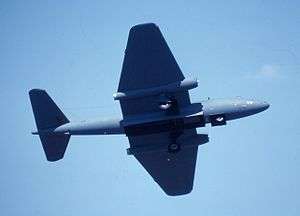
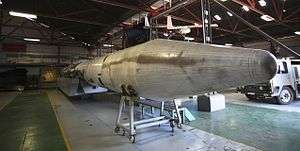
The warheads were originally configured to be delivered from one of several aircraft types then in service with the South African Air Force (SAAF), including the Canberra B12 and the Hawker Siddeley Buccaneer. Concerns about the vulnerability of the aging aircraft to the Cuban anti-aircraft defence network in Angola subsequently led the SADF to investigate missile-based delivery systems.[10]
The missiles were to be based on the RSA-3 and RSA-4 launchers that had already been built and tested for the South African space programme. According to Al J Venter author of How South Africa built six atom bombs these missiles were incompatible with the available large South African nuclear warheads, he claims that the RSA series being designed for a 340 kg payload would suggest a warhead of some 200 kg, "well beyond SA's best efforts of the late 1980s." Venter's analysis is that the RSA series was intended to display a credible delivery system combined with a separate nuclear test in a final diplomatic appeal to the world powers in an emergency even though they were never intended to be used in a weaponized system together.[11]
Three rockets had already been launched into suborbital trajectories in the late 1980s in support of development of the RSA-3 launched Greensat Orbital Management System (for commercial satellite applications of vehicle tracking and regional planning). Following the decision in 1989 to cancel the nuclear weapons program, the missile programs were allowed to continue until 1992, when military funding ended, and all ballistic missile work was stopped by mid-1993. In order to join the Missile Technology Control Regime, the government had to allow American supervision of the destruction of key facilities applicable to both the long range missile and the space launch programmes.[12]
Alleged collaboration with Israel
David Albright and Chris McGreal have claimed that South African projects to develop nuclear weapons during the 1970s and 1980s were undertaken with some cooperation from Israel.[13][14][15] The United Nations Security Council Resolution 418 of 4 November 1977 introduced a mandatory arms embargo against South Africa, also requiring all states to refrain from "any co-operation with South Africa in the manufacture and development of nuclear weapons".[16]
According to the Nuclear Threat Initiative, in 1977 Israel traded 30 grams of tritium for 50 tonnes of South African uranium and in the mid-1980s assisted with the development of the RSA-3 and RSA-4 ballistic missiles, which are similar to Israeli Shavit and Jericho missiles.[17] Also in 1977, according to foreign press reports, it was suspected that South Africa signed a pact with Israel that included the transfer of military technology and the manufacture of at least six nuclear bombs.[18]
In September 1979, a US Vela satellite detected a double flash over the Indian Ocean that was suspected, but never confirmed, to be a nuclear test, despite extensive air sampling by WC-135 aircraft of the United States Air Force. If the Vela Incident was a nuclear test, South Africa is one of the countries, possibly in collaboration with Israel, that is suspected of carrying it out. No official confirmation of its being a nuclear test has been made by South Africa, and expert agencies have disagreed on their assessments. In 1997, South African Deputy Foreign Minister Aziz Pahad stated that South Africa had conducted a test, but later retracted his statement as being a report of rumours.[19]
In February 1994, Commodore Dieter Gerhardt, former commander of South Africa's Simon's Town naval base who was later convicted of spying for the USSR, was reported to have said:
Although I was not directly involved in planning or carrying out the operation, I learned unofficially that the flash was produced by an Israeli-South African test code-named Operation Phoenix. The explosion was clean and was not supposed to be detected. But they were not as smart as they thought, and the weather changed – so the Americans were able to pick it up.[20][21]
In 2000, Gerhardt claimed that Israel agreed in 1974 to arm eight Jericho II missiles with "special warheads" for South Africa.[22]
In 2010, The Guardian released South African government documents that it alleged confirmed the existence of Israel's nuclear arsenal. According to The Guardian, the documents were associated with an Israeli offer to sell South Africa nuclear weapons in 1975.[23][24] Israel categorically denied these allegations and said that the documents do not indicate any offer for a sale of nuclear weapons. Israeli President Shimon Peres said that The Guardian article was based on "selective interpretation... and not on concrete facts."[25] Avner Cohen, author of Israel and the Bomb and the forthcoming The Worst-Kept Secret: Israel's Bargain with the Bomb, said "Nothing in the documents suggests there was an actual offer by Israel to sell nuclear weapons to the regime in Pretoria."[26]
Dismantling
South African forces feared the threat of a "domino effect" in favour of communism, represented in southern Africa by Cuban proxy forces in Angola and threatening Namibia. In 1988, South Africa signed the Tripartite Accord with Cuba and Angola, which led to the withdrawal of South African and Cuban troops from Angola and independence for Namibia. The pre-emptive elimination of nuclear weapons was expected to make a significant contribution toward regional stability and peace, and also to help restore South Africa's credibility in regional and international politics.
South Africa ended its nuclear weapons programme in 1989. All the bombs (six constructed and one under construction) were dismantled and South Africa acceded to the Treaty on the Non-Proliferation of Nuclear Weapons when South African Ambassador to the United States Harry Schwarz signed the treaty in 1991. On 19 August 1994, after completing its inspection, the International Atomic Energy Agency (IAEA) confirmed that one partially completed and six fully completed nuclear weapons had been dismantled. As a result, the IAEA was satisfied that South Africa's nuclear programme had been converted to peaceful applications. Following this, South Africa joined the Nuclear Suppliers Group (NSG) as a full member on 5 April 1995. South Africa played a leading role in the establishment of the African Nuclear-Weapon-Free Zone Treaty (also referred to as the Treaty of Pelindaba) in 1996, becoming one of the first members in 1997. South Africa also signed the Comprehensive Nuclear-Test-Ban Treaty in 1996 and ratified it in 1999.
The Treaty of Pelindaba came into effect on 15 July 2009 once it had been ratified by 28 countries.[27] This treaty requires that parties will not engage in the research, development, manufacture, stockpiling acquisition, testing, possession, control or stationing of nuclear explosive devices in the territory of parties to the treaty and the dumping of radioactive wastes in the African zone by treaty parties. The African Commission on Nuclear Energy, in order to verify compliance with the treaty, has been established and will be headquartered in South Africa.[28]
| Year | Activity |
|---|---|
| 1950s and 1960s | Scientific work on the feasibility of peaceful nuclear explosives and support to nuclear power production efforts |
| 1969 | Atomic Energy Board forms group to evaluate technical and economic aspects of nuclear explosives |
| 1970 | Atomic Energy Commission (AEC) releases report identifying uses for nuclear explosives |
| 1971 | R&D approval granted for "peaceful use of nuclear explosives" |
| 1973 | AEC prioritises work on a gun-type design |
| 1974 | Work on a nuclear device and the Vastrap test site are authorised |
| 1977 | AEC completes bomb assembly for "cold" test |
| 1978 | First HEU produced; Armscor assumes control of weapons programme |
| 1979 | Vela Incident; First bomb with HEU core produced by AEC |
| 1982 | First deliverable bomb built; work on weapons safety |
| 1985 | Three-phase nuclear strategy reviewed |
| 1987 | First production bomb built; seven produced, with an eighth under construction |
| 1988 | Armscor prepares Vastrap for a nuclear test |
| 1989 | Nuclear weapons dismantled |
| 1991 | Accedes to NPT |
In popular culture
The South African nuclear weapons programme forms a key part of the plot of The Girl Who Saved the King of Sweden, a popular novel by Jonas Jonasson.
Biological and chemical weapons
In October 1998, the report of the South African Truth and Reconciliation Commission included a chapter on Project Coast, a clandestine government chemical and biological warfare program conducted during the 1980s and 1990s. Project Coast started in 1983, ostensibly to produce equipment for defensive purposes, including masks and protective suits. Despite vehement assertions to the contrary, some testimony appeared to show that the programme went well beyond defensive purposes.
See also
- History of biological warfare
- Helikon vortex separation process
- Military history of South Africa
- Nuclear weapons and Israel
- Denel Overberg Test Range
- Cold War
Notes
- 1 2 3 4 5 6 7 8 9 10 11 Executive release. "South African nuclear bomb". Nuclear Threat Initiatives. Nuclear Threat Initiatives, South Africa (NTI South Africa). Retrieved 13 March 2012.
- ↑ Von Wielligh, N. & von Wielligh-Steyn, L. (2015). The Bomb – South Africa’s Nuclear Weapons Programme. Pretoria: Litera.
- ↑ John Pike. "Nuclear Weapons Program – South Africa". Globalsecurity.org. Retrieved 15 May 2011.
- 1 2 3 Chaudhry, PhD (Political science), M.A. "Separating Myth from Reality§ The Uranium Enrichment programme: Building Kahuta Research Laboratories (KRL)". Professor Mohammad Ali Chaudhry (professor of Political Science). M.A. Chaudhry's article published at the The Nation, 1999. Retrieved 5 March 2012.
- ↑ "South Africa: Nuclear Case Closed?" (PDF). National Security Archive. 19 December 1993. Retrieved 26 August 2008.
- 1 2 Lewis, Jeffrey (3 December 2015). "Revisiting South Africa's Bomb". Arms Control Wonk. Leading Voices on Arms Control, Disarmament and Non-Proliferation. Retrieved 6 December 2015.
- ↑ U.S. Military Involvement in Southern Africa. South End Press. 1978. ISBN 0-89608-041-2.
- ↑ "South Africa and the Affordable Bomb". Bulletin of the Atomic Scientists. Jul 1994: 41.
- ↑ Frank V. Pabian. "South Africa's Nuclear Weapon Program: Lessons For U.S. Non Proliferation Policy" (PDF). James Martin Center for Nonproliferation Studies. p. 8. Retrieved 8 December 2008.
- ↑ https://books.google.com/books?id=M7wIryQK6UkC&pg=PA10
- ↑ http://www.defenceweb.co.za/index.php?option=com_content&view=article&id=5942:book-review-how-sa-built-six-atom-bombs-&catid=57:Book%20Reviews&Itemid=141
- ↑ Jericho
- ↑ Chris McGreal (7 February 2006). "Brothers in arms — Israel's secret pact with Pretoria". The Guardian. London.
- ↑ South Africa and the affordable bomb (David Albright) "South Africa and the affordable bomb" Check
|url=value (help). Bulletin of the Atomic Scientists. August 1994. - ↑ Unknown author. "RSA Nuclear Weapons Program". Federation of American Scientists.
- ↑ "UNSCR 418 of 4 November 1977: States should refrain from "any co-operation with South Africa in the manufacture and development of nuclear weapons"". United Nations. Retrieved 15 May 2011.
- ↑ "South Africa: Missile". Nuclear Threat Initiative. November 2011.
- ↑ "P.W. Botha felt Israel had betrayed him". Jerusalem Post. 2 November 2006. Retrieved 2 November 2006.
- ↑ "Aziz Pahad's statement and retraction discussed here". Nuclearweaponarchive.org. Retrieved 15 May 2011.
- ↑ South Africa and the affordable bomb, David Albright, The Bulletin of the Atomic Scientists Jul 1994, pp 37.
- ↑ Proliferation: A flash from the past David Albright, The Bulletin of the Atomic Scientists Nov 1997, pp. 15
- ↑ "Tracking Nuclear Proliferation". PBS Newshour. 2 May 2005.
- ↑ McGreal, Chris (24 May 2010). "Revealed: how Israel offered to sell South Africa nuclear weapons". The Guardian. UK. Retrieved 24 May 2010.
- ↑ McGreal, Chris (24 May 2010). "The memos and minutes that confirm Israel's nuclear stockpile". The Guardian. UK. Retrieved 24 May 2010.
- ↑ Kershner, Isabel (24 May 2010). "Israel Denies It Offered South Africa Warheads". The New York Times.
- ↑ "Avner Cohen: Yitzhak Rabin would have opposed sale of nuclear weapons". The Independent. London. 25 May 2010.
- ↑ disarmament.un.org - Pelindaba Treaty - View chronological order by deposit
- ↑ "African Nuclear Weapons Free Zone Treaty". Department of Foreign Affairs, Republic of South Africa. Retrieved 2006-07-28.
- ↑ Roy E. Horton, USAF Institute for National Security Studies (1999). Out of (South) Africa: Pretoria's Nuclear Weapons Experience. Dianne Publishing. p. 17.
References
- Joseph Cirincione, Jon B. Wolfsthal, Miriam Rajkumar. Deadly Arsenals: Nuclear, Biological, and Chemical Threats. Washington D.C.: Carnegie Endowment For International Peace, 2005.
External links
| Wikimedia Commons has media related to Nuclear weapons program of South Africa. |
- Birth and Death of the South African Nuclear Weapons Programme, Waldo Stumpf, Atomic Energy Corporation of South Africa, October 1995
- South Africa and the nuclear option, Marcus Duvenhage, 1998
- Out of South Africa: Pretoria’s Nuclear Weapons Experience (in pdf), Lt. Col. Roy E. Horton, ACDIS Occasional Paper, Program in Arms Control, Disarmament, and International Security, University of Illinois, August 2000
- Out of (South) Africa: Pretoria’s Nuclear Weapons Experience, Roy E. Horton, USAF Institute for National Security Studies, August 1999
- Nuclear Files.org guide to proliferation – South Africa
- The Nuclear Weapon Archive account of South Africa
- Israel conducted nuclear experiment in 1979
- South Africa's Nuclear Autopsy: The Risk Report, Wisconsin Project on Nuclear Arms Control, 1996
- Nuclear verification in South Africa, Adolf von Baeckmann, Gary Dillon and Demetrius Perricos, IAEA Bulletin Volume 37 Number 1
- Annotated bibliography for the South African Nuclear Program from the Alsos Digital Library for Nuclear Issues
- South Africa's Nuclear Weapons Storage Vault
- Israel and the South African Bomb
- The Woodrow Wilson Center's Nuclear Proliferation International History Project The Wilson Center's Nuclear Proliferation International History Project conatins primary source material on South Africa's nuclear weapons program.